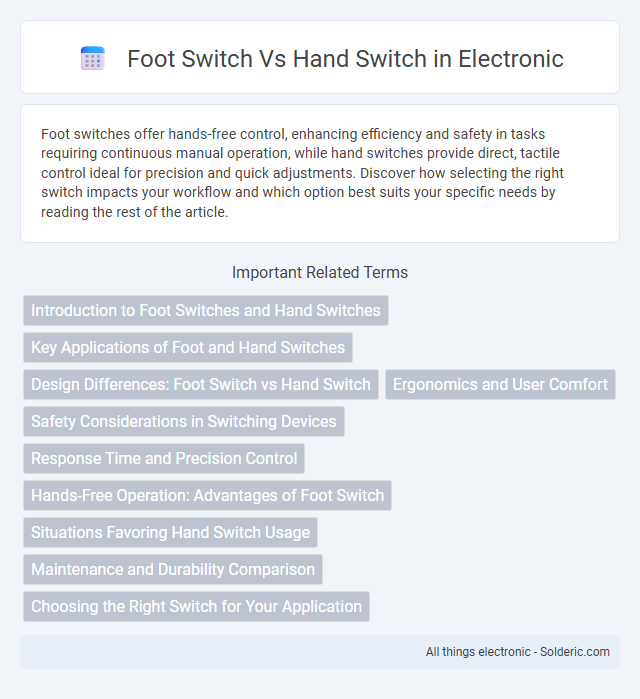Foot switches offer hands-free control, enhancing efficiency and safety in tasks requiring continuous manual operation, while hand switches provide direct, tactile control ideal for precision and quick adjustments. Discover how selecting the right switch impacts your workflow and which option best suits your specific needs by reading the rest of the article.
Comparison Table
| Feature | Foot Switch | Hand Switch |
|---|---|---|
| Operation | Activated by foot pressure | Activated by hand movement or press |
| Hands-Free Usage | Yes, allows hands-free control | No, requires hand use |
| Common Applications | Industrial machines, musical instruments, medical devices | Consumer electronics, tools, light switches |
| Ergonomics | Reduces hand fatigue, allows multitasking | Simple to use but occupies one hand |
| Durability | Designed for heavy, repetitive use | Varies; generally less robust than foot switches |
| Portability | Less portable due to size and base | Typically compact and lightweight |
Introduction to Foot Switches and Hand Switches
Foot switches and hand switches serve as essential control devices in various industrial and medical applications, offering hands-free and manual operation respectively. Foot switches enable you to activate machinery or tools using your foot, enhancing efficiency and safety by freeing your hands for other tasks. Hand switches provide direct manual control with ease of access, making them ideal for precise or quick on-off actions in diverse environments.
Key Applications of Foot and Hand Switches
Foot switches are predominantly used in industrial machinery, medical devices, and musical instruments where hands-free operation enhances efficiency and safety. Hand switches excel in precision control tasks such as power tools, robotics, and gaming controllers, offering quick and intuitive manual activation. Both switches serve critical roles in ergonomic design, ensuring user comfort and optimal performance in specialized environments.
Design Differences: Foot Switch vs Hand Switch
Foot switches feature a robust, pedal-like design optimized for hands-free operation, enhancing efficiency in environments requiring frequent on/off commands. Hand switches prioritize ergonomic form with compact, button-based controls tailored for precise manual input and ease of grip. Your choice between the two should consider the operational context and the need for either hands-free or direct manual control.
Ergonomics and User Comfort
Foot switches enhance ergonomics by allowing users to keep their hands free, reducing strain and enabling multitasking during prolonged tasks. Hand switches, while offering direct control and immediate feedback, can lead to increased hand fatigue and repetitive strain injuries if used continuously. Optimal user comfort depends on task duration and the need for hands-free operation, with foot switches preferred for extended use and hand switches for precision control.
Safety Considerations in Switching Devices
Foot switches reduce the risk of repetitive strain injuries by allowing hands-free operation, enhancing safety in environments requiring frequent switching. Hand switches offer precise control but may increase exposure to hazards if hands are occupied or contaminated, raising the chance of accidents. Your choice of switching device should prioritize ergonomic safety and operational context to minimize injury and ensure reliable control.
Response Time and Precision Control
Foot switches generally offer faster response times in scenarios requiring quick, hands-free activation, enhancing workflow efficiency in medical, industrial, and musical applications. Hand switches provide superior precision control due to direct manual input, making them ideal for tasks demanding accuracy and delicate adjustments. The choice between foot and hand switches depends largely on the need for rapid response versus fine control, balancing speed and precision based on specific use cases.
Hands-Free Operation: Advantages of Foot Switch
Foot switches offer the significant advantage of hands-free operation, allowing you to control devices without interrupting your manual tasks. This feature enhances efficiency and safety in environments such as medical procedures, workshops, and musical performances. By using a foot switch, your hands remain free for precise work while maintaining seamless device control.
Situations Favoring Hand Switch Usage
Hand switches are preferred in situations requiring precise and rapid control, such as operating machinery with complex, fine-tuned functions or in environments where immediate manual feedback is essential. They are ideal for tasks demanding dexterity and quick adjustments, like in medical equipment or intricate manufacturing processes. Ergonomic design and ease of access also make hand switches suitable when frequent activation is necessary without the risk of foot fatigue or unintended activation.
Maintenance and Durability Comparison
Foot switches typically experience more wear and tear due to constant pressure and foot movements, requiring more frequent maintenance to ensure reliable performance. Hand switches generally have a longer lifespan as they endure less mechanical stress and are less prone to accidental damage. Your choice between these switches should consider the operational environment to balance maintenance needs and durability effectively.
Choosing the Right Switch for Your Application
Selecting the right switch for your application depends on the specific control needs and operational environment. Foot switches offer hands-free operation, making them ideal for tasks that require manual dexterity or involve multiple tools simultaneously. Hand switches provide more direct control and tactile feedback, suitable for precise or frequent activation where your hand is readily available.
Foot switch vs Hand switch Infographic

 solderic.com
solderic.com